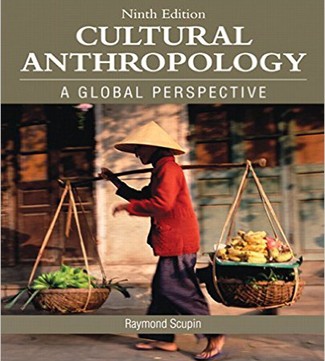Cultural Anthropology A Global Perspective 9th Edition Scupin Test Bank
$35.00 Original price was: $35.00.$26.50Current price is: $26.50.
Cultural Anthropology A Global Perspective 9th Edition Scupin Test Bank
Instant download Cultural Anthropology A Global Perspective 9th Edition Scupin Test Bank pdf docx epub after payment.

CHAPTER 3
CULTURE
True-False Questions
1. Culture consists of both material and nonmaterial components.
Answer: T
Topic: The Characteristics of Culture
Learning Objective: LO 3.1 Discuss the basic characteristics and components of culture as understood by anthropologists.
Skill Level: Understand the Concepts
Difficulty Level: Easy
2. Culture can be defined as a shared way of life that includes values, beliefs, and norms that are transmitted within a particular society from generation to generation.
Answer: T
Topic: The Characteristics of Culture
Learning Objective: LO 3.1 Discuss the basic characteristics and components of culture as understood by anthropologists.
Skill Level: Understand the Concepts
Difficulty Level: Easy
3. A society and a culture are synonymous.
Answer: F
Topic: The Characteristics of Culture
Learning Objective: LO 3.1 Discuss the basic characteristics and components of culture as understood by anthropologists.
Skill Level: Understand the Concepts
Difficulty Level: Easy
4. Many anthropologists have adopted the term “sociocultural” to encompass both “society” and “culture” since societies are complex, consist of distinctive groups, and maintain cultural traditions.
Answer: T
Topic: The Characteristics of Culture
Learning Objective: LO 3.1 Discuss the basic characteristics and components of culture as understood by anthropologists.
Skill Level: Understand the Concepts
Difficulty Level: Easy
5. Social learning is a process that can be observed in nonhuman creatures.
Answer: T
Topic: Culture Is Learned
Learning Objective: LO 3.2 Discuss how humans acquire their culture.
Skill Level: Understand the Concepts
Difficulty Level: Easy
6. The unique capacity for culture in the human species depends on learning since we do not inherit our culture through our genes.
Answer: T
Topic: Culture Is Learned
Learning Objective: LO 3.2 Discuss how humans acquire their culture.
Skill Level: Understand the Concepts
Difficulty Level: Easy
7. Symbols are directly associated with concrete physical objects or activities, while signs are arbitrary units of meaning.
Answer: F
Topic: Culture Is Learned
Learning Objective: LO 3.2 Discuss how humans acquire their culture.
Skill Level: Understand the Concepts
Difficulty Level: Easy
8. A worldview consists of various beliefs about the nature of reality that provide people with a means of interpreting and understanding the world around them.
Answer: T
Topic: Aspects of Culture
Learning Objective: LO 3.4 Discuss the components of nonmaterial culture studied by anthropologists.
Skill Level: Understand the Concepts
Difficulty Level: Easy
9. Most people in a given society assume that their beliefs are rational and firmly grounded in common sense.
Answer: T
Topic: Aspects of Culture
Learning Objective: LO 3.4 Discuss the components of nonmaterial culture studied by anthropologists.
Skill Level: Understand the Concepts
Difficulty Level: Easy
10. Norms are defined as the formal and explicit set of laws that apply to all people in all times and places.
Answer: F
Topic: Aspects of Culture
Learning Objective: LO 3.4 Discuss the components of nonmaterial culture studied by anthropologists.
Skill Level: Understand the Concepts
Difficulty Level: Moderate
11. Minority groups are often forced to accept the ideologies of the economically and politically dominant groups through the process of cultural hegemony.
Answer: T
Topic: Aspects of Culture
Learning Objective: LO 3.4 Discuss the components of nonmaterial culture studied by anthropologists.
Skill Level: Understand the Concepts
Difficulty Level: Moderate
12. Folkways and mores are two different types of norms.
Answer: T
Topic: Aspects of Culture
Learning Objective: LO 3.4 Discuss the components of nonmaterial culture studied by anthropologists.
Skill Level: Remember the Facts
Difficulty Level: Easy
13. Ideal culture consists of what people say they do or should do.
Answer: T
Topic: Aspects of Culture
Learning Objective: LO 3.4 Discuss the components of nonmaterial culture studied by anthropologists.
Skill Level: Understand the Concepts
Difficulty Level: Easy
14. Ethnocentrism is the practice of judging another society by the standards and values of one’s own society.
Answer: T
Topic: Cultural Diversity
Learning Objective: LO 3.5 Describe how culture results in differences among people in various societies.
Skill Level: Understand the Concepts
Difficulty Level: Easy
15. According to Marvin Harris, the dietary practices of various cultures may be rooted in ecological conditions.
Answer: T
Topic: Cultural Diversity
Learning Objective: LO 3.5 Describe how culture results in differences among people in various societies.
Skill Level: Remember the Facts
Difficulty Level: Moderate
16. Anthropologists have determined that specific food preferences are biologically based and not culturally influenced.
Answer: F
Topic: Cultural Diversity
Learning Objective: LO 3.5 Describe how culture results in differences among people in various societies.
Skill Level: Remember the Facts
Difficulty Level: Easy
17. Cultural diversity is a reflection of environmental adaptations and the consequence of symbolic creations.
Answer: T
Topic: Cultural Diversity
Learning Objective: LO 3.5 Describe how culture results in differences among people in various societies.
Skill Level: Understand the Concepts
Difficulty Level: Moderate
18. The importance of dreadlocks in the Rastafarian movement of Jamaica is an example of resistance to cultural norms.
Answer: T
Topic: Cultural Diversity
Learning Objective: LO 3.5 Describe how culture results in differences among people in various societies.
Skill Level: Remember the Facts
Difficulty Level: Moderate
19. The striking feature of cultural universals is the fact that the specific content and practice do not vary from society to society.
Answer: F
Topic: Cultural Universals
Learning Objective: LO 3.6 Describe how culture leads to universal similarities among people in widely separated societies.
Skill Level: Understand the Concepts
Difficulty Level: Moderate
20. Ethnicity is based on perceived differences in ancestral origins or descent and shared history and cultural heritage.
Answer: T
Topic: Cultural Diversity
Learning Objective: LO 3.5 Describe how culture results in differences among people in various societies.
Skill Level: Understand the Concepts
Difficulty Level: Moderate
Multiple-Choice Questions
21. A way of life shared by a group of human beings—including their language, beliefs, and things they make and use—is referred to by anthropologists as their __________.
A. religion
B. heritage
C. culture
D. environment
Answer: C
Topic: The Characteristics of Culture
Learning Objective: LO 3.1 Discuss the basic characteristics and components of culture as understood by anthropologists.
Skill Level: Understand the Concepts
Difficulty Level: Easy
22. __________ is credited with providing us with the first detailed definition of culture, “. . . that complex whole which includes knowledge, belief, arts, morals, law, custom, and any other capabilities and habits acquired by man as a member of society.”
A. Leslie White
B. E. B. Tylor
C. Clifford Geertz
D. Marvin Harris
Answer: B
Topic: The Characteristics of Culture
Learning Objective: LO 3.1 Discuss the basic characteristics and components of culture as understood by anthropologists.
Skill Level: Remember the Facts
Difficulty Level: Easy
23. Which one of the following statements concerning a society is true?
A. A society is the same thing as a culture.
B. Society generally refers to a particular group of animals living and interacting within a definite territory.
C. A society is a grouping unique to humans.
D. Society is defined as a shared way of life that includes values, beliefs, and norms.
Answer: B
Topic: The Characteristics of Culture
Learning Objective: LO 3.1 Discuss the basic characteristics and components of culture as understood by anthropologists.
Skill Level: Understand the Concepts
Difficulty Level: Easy
24. In order for an item to be cultural, it must be __________.
A. unchanging, fixed, or static
B. learned and commonly shared among individuals
C. independent of environmental influences
D. dependent upon the environment of the society
Answer: B
Topic: The Characteristics of Culture; Culture Is Learned; Culture Is Shared
Learning Objective: LO 3.1 Discuss the basic characteristics and components of culture as understood by anthropologists; LO 3.2 Discuss how humans acquire their culture; LO 3.3 Discuss how anthropologists understand the sharing of culture.
Skill Level: Understand the Concepts
Difficulty Level: Easy
25. There are many definitions of culture; however, there are a number of aspects that are common to most definitions. One such aspect is that __________.
A. culture is shared uniformly by all members of a society
B. culture is learned and transmitted across generations
C. culture is biologically inherited
D. culture is composed of material objects
Answer: B
Topic: The Characteristics of Culture; Culture Is Learned; Culture Is Shared
Learning Objective: LO 3.1 Discuss the basic characteristics and components of culture as understood by anthropologists; LO 3.2 Discuss how humans acquire their culture; LO 3.3 Discuss how anthropologists understand the sharing of culture.
Skill Level: Understand the Concepts
Difficulty Level: Moderate
26. There are a number of different ways that one can learn things. Both humans and other animals learn by trial-and-error and by social learning. The form of learning that is uniquely human and that provides the basis for the capacity for culture is known as __________.
A. moment learning
B. critical learning
C. symbolic learning
D. inventive learning
Answer: C
Topic: Culture Is Learned
Learning Objective: LO 3.2 Discuss how humans acquire their culture.
Skill Level: Understand the Concepts
Difficulty Level: Moderate
Related products
Test Bank
Test Bank for Clinical Immunology and Serology A Laboratory Perspective, 3rd Edition: Stevens











